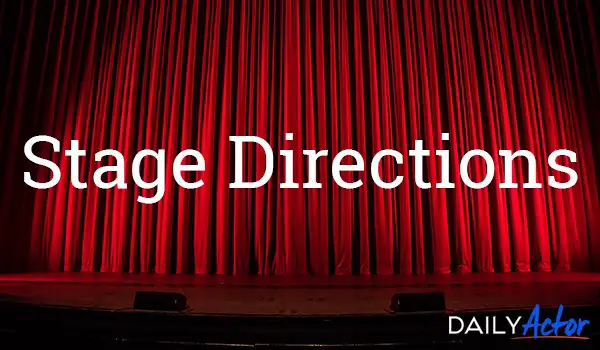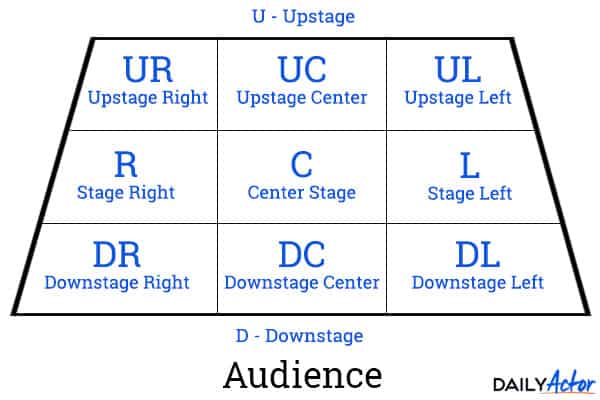
Stage Directions: Definition, Examples and Abbreviations
- Estragon, sitting on a low mound, is trying to take off his boot. He pulls at it with both hands, panting.
- From the right, Willy Loman, the Salesman, enters, carrying two large sample cases.
- Presently the STAGE MANAGER, hat on and pipe in mouth, enters and begins placing a table and three chairs downstage left and a table and three chairs downstage right.
- Exit, pursued by a bear.
What do each of these lines from famous plays have in common?
They’re all examples of stage directions.
As you can see, some are quite simple (a man walks across the stage; someone tries to take off a boot), while others are more complicated (just what do “downstage left” and “downstage right” mean?).
One of the first things every actor needs to learn is what stage directions mean, why they exist, and how to interpret them.
What are Stage Directions?
Stage directions are instructions in the script of a play that tell actors how to enter, where to stand, when to move, and so on.
Stage directions can also include instructions about lighting, scenery, and sound effects, but their main purpose is to guide actors through their movements onstage. (Onstage movement and positioning is called blocking).
For example, stage directions may tell an actor to pace while delivering their lines, to pick up a prop at a certain moment, or to sit down while listening to another character speak.
Movements like these can add tension, humor, or emotion to a scene, engage the audience’s attention, and make a character come alive.
Stage Directions Examples and Abbreviations
To save time, playwrights and directors sometimes use abbreviations. Luckily, these are pretty straightforward:

But wait! there’s more: DRC: Downstage right-center, DLC: Downstage left-center, RC: Right center, LC: Left center, URC: Upstage right-center and ULC: Upstage left-center
Stage Direction Basics: Right, Left, Up, Down, Center
Upstage, Downstage, Stage Right, Stage Left — to new actors who aren’t familiar with the language of stage directions, these terms can be confusing. What do they all mean?
First of all, it helps to understand that stage directions are given from the perspective of an actor facing the audience. So, stage right and stage left are the actor’s right and left, not the audience’s.
When you’re standing in the middle of the stage with your face toward the audience, stage right is the area of the stage to your right, and stage left is the area of the stage to your left.
What about center stage? As you can probably guess, this is simply the middle of the stage. When you’re standing center stage, you’re at the center of all the action: between right and left and up and down.
Speaking of which, the other main terms are upstage and downstage. What’s called Upstage refers to the part of the stage farthest from the audience. Downstage is the part of the stage closest to the audience.
These terms make more sense if you know a little theatre history.
The Beginnings of Stage Directions: Stage Left vs Stage Right and Upstage vs Downstage
During the Renaissance, theaters weren’t quite as sophisticated as they are today, and many audience members would have to stand for the entirety of a play.
Imagine being one of Shakespeare’s groundlings: the common people who couldn’t afford a seat at the theatre and had to stand on the ground in front of the stage. Your head might be level with the stage, and there would probably be people standing in front of you. If an actor stood at the front of the stage, you might see them, but if they went to the back of the stage, away from you, you’d barely even catch a glimpse.
To solve this problem, stages were tilted so that the back was higher than the front, allowing the audience to see the actors at all times.
This meant that an actor walking away from the audience would literally be walking up an incline, while an actor coming toward the audience would be going down. And that’s how we got “upstage” and “downstage.”
Putting It All Together: Right-Center, Left-Center and More
Now that you know the basics, try to visualize a stage separated into several sections. From front to back, you have upstage, center stage, and downstage. From right to left: stage right, center stage, and stage left.
If you’re acting on an especially large stage, you might hear the terms “left-center,” “right-center,” or even something like “downstage right-center.”
Before your head starts to spin, just think back to the basics.
If you know where center stage is and where stage right and left are, you can figure out that the area between center stage and stage right is right-center stage, and the area between center stage and stage left is left-center. Downstage right-center would be the downstage area between center stage and stage right, and so on.
Stage Directions: More Guidelines Than Actual Rules
Now that you know your stage directions, here’s a final note: stage directions are meant to help, not hinder.
A playwright adds these instructions as guidelines to help shape a performance, but ultimately, the final say rests with the actors and director.
